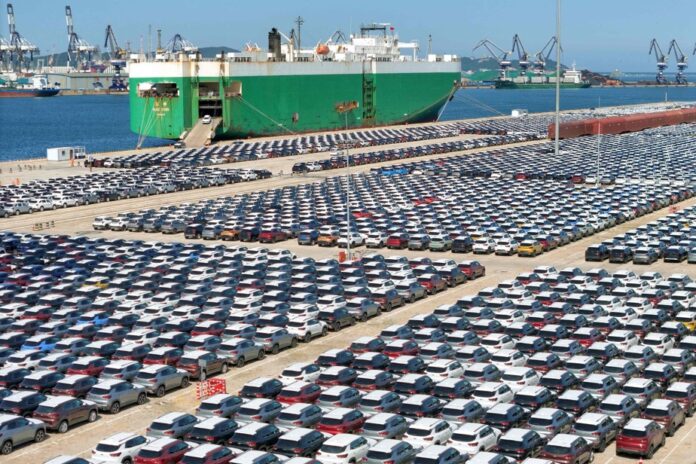(Yizheng, China) With many Chinese exports losing momentum and consumers spending less at home, the country is flooding the world with cars.
The demand abroad for cheap Chinese-built vehicles, especially gasoline models that Chinese consumers are now shunning in favor of electric cars, is so strong that the main obstacle to selling these vehicles abroad is the lack of specialized ships to transport them.
Since the start of the war in Ukraine, Chinese automakers have established themselves in Russia by transporting cars by train. They have also captured large market shares in Southeast Asia, Australia, South America and Mexico. With Trump-era tariffs holding back U.S. sales, Chinese automakers are plotting a big offensive in Europe — once they have enough ships.
Shipyards along the Yangtze are building a fleet of car carriers that serve as giant floating parking lots, capable of carrying 5,000 or more cars at a time.
The Jinling shipyard in Yizheng, a city near Nanjing, “is busy 24 hours a day, there are night shifts every day,” says Feng Wanyou, a ship welder, during a meal break.
Global exports of Chinese goods, from furniture to consumer electronics, fell 5.5% in the first eight months of the year, data showed Thursday. But China’s auto industry has quadrupled its exports in just three years, overtaking Japan as the world leader this year. This year, car exports jumped 86% through July.
Chinese households’ appetite for spending – on new cars and almost everything else – has declined as property prices have fallen. Consumer confidence has shown few signs of recovery, even after nearly three years of strict “zero COVID” policies were lifted.
When Chinese households buy cars, they increasingly choose electric vehicles built by local manufacturers, who are at the forefront of global EV production. The result is a huge supply of gasoline models that Chinese consumers no longer want, but which are still sold abroad.
Chinese automakers are stuck with unused factory capacity to build around 15 million gasoline-powered cars a year. They responded by sending more than 4 million cars this year to overseas markets at rock bottom prices.
“Why did they increase their exports? Because they’re forced to shut down a factory,” says Bill Russo, former CEO of Chrysler China and now CEO of Automobility, a Shanghai consulting firm.
All over the world, Chinese car manufacturers are gaining market share. Steel and electronic components used in cars are cheap in China, giving automakers an advantage. Local Chinese authorities also give companies almost free land, near-zero interest loans and other subsidies.
After years of quality gains and technological improvements, Chinese cars, even those with outdated combustion engines, are turning heads at industry events like last week’s Munich auto show.
In Australia, Chinese automakers have overtaken their South Korean rivals in sales and are catching up with their Japanese rivals. China has also rapidly expanded its exports to Mexico and Britain, and is beginning to increase shipments to Belgium and Spain, which have major car unloading ports serving as gateways to other countries. other countries of the European Union.
The lack of ships has prevented China from exporting more.
“The Chinese are building cars much faster than ships,” says Michael Dunne, former president of General Motors Indonesia.
This situation is starting to change.
Chinese automakers like BYD and Chery, along with the European and Singaporean shipping companies that transport the cars for them, have placed almost all of the world’s outstanding orders for 170 car transport ships. Before China’s auto export boom, only four ships a year were ordered, says Daniel Nash, head of vehicle carriers at London-based shipping data firm VesselsValue.
The shipyards located upstream and downstream of the Yangtze, which employ thousands of workers, are busy from dawn until late at night. The frenzy was visible on September 1 at the Jinling shipyard, where workers neared completion of two car carriers for Singapore’s Eastern Pacific Shipping.
Li Cha, a welder, says he works 12-hour shifts, with a two-hour break at midday to cycle home for lunch. Floodlights illuminate the shipyard at night to allow crews to carry out particularly urgent tasks, such as installing electrical systems.
The value of building more ships is obvious. The daily cost for an automaker to rent a car-carrying vessel has soared to US$105,000 from US$16,000 two years ago, Nash said. BYD is spending nearly $100 million apiece to build what will be the six largest car carrier ships ever built. Most of the ships are expected to be completed within the next three years.
Europe is becoming the main target for most Chinese car manufacturers. They use brands like Volvo and MG, acquired many years ago, to gain greater acceptance in Europe.
State-owned Shanghai Automotive Industry Corp. (SAIC), which acquired the famous British brand MG in 2007, exports cheap cars from China not only to Britain, but also to Australia. MG re-emerged in Australia this year as one of the country’s best-selling car brands.
General Motors’ joint venture with SAIC has begun shipping Chevrolet Aveo subcompact cars to Mexico, for sale in June starting at US$16,300.
Among the top destinations for Chinese car exports, one major market is conspicuous by its absence: the United States. Almost no Chinese cars go there now, and few are expected to do so soon.
When the Trump administration imposed tariffs on imports from China in 2018 and 2019, the first batch included 25% levies on gasoline and electric cars, as well as gasoline engines and batteries of electric cars. Not only are the tariffs still in place, but they were issued under legislation that gives broad discretion to the U.S. Trade Representative, currently Katherine Tai, to increase them if necessary.















